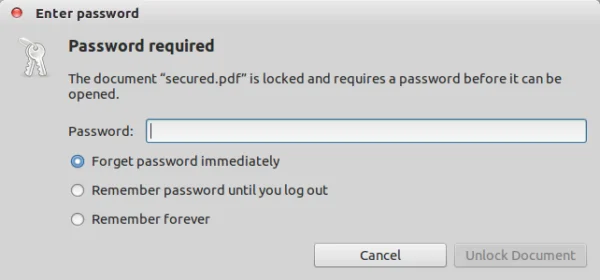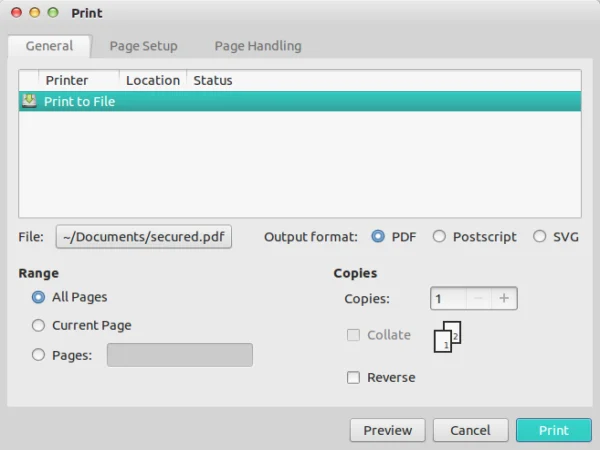How to remove password protection from PDF in Ubuntu
Portable Document Format (PDF) is one of the most frequently used file formats today. Today's article will discuss some ways to achieve this.
Create an unsecured PDF file from the command line
This method requires the command line utilities pdftops and ps2pdf to be installed on the Linux system. If you are running Ubuntu, these utilities are already available, otherwise you can install them by running the following command:
sudo apt-get install xpdf-utils contextOnce all the requirements are ready, first execute the pdftops command (syntax below) to convert the password-protected PDF file to a postscript (.ps) file:
pdftops -upw [password] [complete-path-to-pdf-file] [complete-path-to-ps-file]In the command sample shown above, the -upw option is used to specify the user password for the PDF file. Replace [password], [complete-path-to-pdf-file] and [complete-path-to-ps-file] with the actual password used to open the .pdf file, the path of the pdf file and the location to save the .ps file. In this case, these two files are: '~/Downloads/PDF/secured.pdf' and '~/Downloads/PDF/unsecured.ps' respectively.
When running this command, the postscript file (.ps) will be created at the location specified in the command.

The next step is to convert this postscript file into a .pdf file, which can be easily done using the ps2pdf command. This is the command used in the example case:
ps2pdf ~/Downloads/PDF/unsecured.ps ~/Downloads/PDF/unsecured.pdfand it creates 'unsecured.pdf' in the same folder.

Now, when you open this newly created PDF file, it will not ask for a password.
Create insecure PDF files with Document Viewer
This method focuses on achieving the same using Document Viewer, the default PDF viewer in Ubuntu. First, open the password-protected PDF file in Document Viewer by entering the password:

Once the file is open, go to File -> Print and make sure the 'Print to File' option in the 'General' tab is selected.

Then, make sure that the file option contains the output PDF name and location of your choice - this information can be changed by clicking the button where the information is displayed. The example changed the output file name from 'secured.pdf' to 'no-password.pdf'.

Now, simply click on the 'Print' button and the unsecured PDF file will be saved at the location specified in the File option, in this case '~/Documents'.
Try opening a new file now and it will not ask you to enter any password.
Of course, these are not the only two ways to create an unsecured .pdf file from a password-protected file, but the methods discussed in this article will give you an idea of how to achieve the same thing. yourself using the command line as well as the GUI.
Have you ever tried any of these (or any other) methods to create an unsecured .pdf file? How was your experience? Share your thoughts in the comments section below!
You should read it
- What's new in Ubuntu 18.04 LTS just released?
- How to prolong the life of Ubuntu 18.04 installation with Ubuntu Pro
- What is the difference between Ubuntu Desktop and Ubuntu Server?
- Ubuntu 21.04 users need to update the system ASAP
- 5 things to do after upgrading to Ubuntu 22.04 LTS
- 5 Reasons Ubuntu Cinnamon Is Better Than Other Ubuntu Versions
- 7 reasons to upgrade to Ubuntu 23.04
- Ubuntu 19.10: Roadmap for release & planned features
May be interested
- Remove viruses from Windows PC with Ubuntu Live USB
 your windows computer is infected with a virus or worse, you can't even start it. if you own a cd or ubuntu live usb, you can use it to clean your pc and try to recover windows.
your windows computer is infected with a virus or worse, you can't even start it. if you own a cd or ubuntu live usb, you can use it to clean your pc and try to recover windows. - How to remove PDF file password on Mac
 sometimes you also need to remove the password that protects your pdf file so that everyone can access and view it without limits.
sometimes you also need to remove the password that protects your pdf file so that everyone can access and view it without limits. - How to Solve Incorrect Password ...Try Again Error in Ubuntu
 this short article will show you how solve 'incorrect password ...try again' error in ubuntu 13.04 raring ringtail. you get this error mostly when you trying to run some software on your system that need root password. why is that? it's...
this short article will show you how solve 'incorrect password ...try again' error in ubuntu 13.04 raring ringtail. you get this error mostly when you trying to run some software on your system that need root password. why is that? it's... - Ways to reset BIOS password or remove BIOS password
 clear the bios password, set the bios to default mode in case you forget the bios password, buy an old device without knowing the bios password, here are ways you can use it.
clear the bios password, set the bios to default mode in case you forget the bios password, buy an old device without knowing the bios password, here are ways you can use it. - Why is Ubuntu LTS preferred over regular distros?
 ubuntu is one of the most widely used linux distributions among software developers and other content creators. ubuntu is also used for many servers around the globe.
ubuntu is one of the most widely used linux distributions among software developers and other content creators. ubuntu is also used for many servers around the globe. - How to remove PDF file password
 setting a password for pdf files is the easiest way to protect the content inside. however, sometimes you want to cancel the created password to make it easier to share it with everyone.
setting a password for pdf files is the easiest way to protect the content inside. however, sometimes you want to cancel the created password to make it easier to share it with everyone. - What's new in Ubuntu 18.04 LTS just released?
 ubuntu 18.04 lts code-named bionic beaver has just been officially launched on april 26th. this version is canonical's up to 5 year support period.
ubuntu 18.04 lts code-named bionic beaver has just been officially launched on april 26th. this version is canonical's up to 5 year support period. - How to Remove the Password from a Zip File Without Knowing the Password
 this wikihow teaches you how to gain access to a zip folder which has an unknown password. the only way to do this is by downloading a program which can crack the password for you, though the process of cracking the password can take days...
this wikihow teaches you how to gain access to a zip folder which has an unknown password. the only way to do this is by downloading a program which can crack the password for you, though the process of cracking the password can take days... - How to set password protection folder on Mac
 on macos, the folders are not encrypted directly, but you can set a password to protect it. this is an effective way of protecting folders and files contained therein.
on macos, the folders are not encrypted directly, but you can set a password to protect it. this is an effective way of protecting folders and files contained therein. - Instructions for setting up 2-layer protection for Outlook accounts and Microsoft accounts
 microsoft provides users with 3 options to set up 2-layer protection. you can use your email address, phone number or use the authenticator application to set up 2-layer protection for your outlook and microsoft accounts.
microsoft provides users with 3 options to set up 2-layer protection. you can use your email address, phone number or use the authenticator application to set up 2-layer protection for your outlook and microsoft accounts.










 Why should you consider deleting your Temu account?
Why should you consider deleting your Temu account? 7 Android features that help reduce travel anxiety
7 Android features that help reduce travel anxiety Cheap smartphones can have serious privacy problems
Cheap smartphones can have serious privacy problems The original Snapdragon X Elite benchmark couldn't even beat the Apple M3, let alone the M4!
The original Snapdragon X Elite benchmark couldn't even beat the Apple M3, let alone the M4! How to log in to SSH server with GPG key
How to log in to SSH server with GPG key List of Samsung Galaxy devices that will not be updated to One UI 7 (Android 15)
List of Samsung Galaxy devices that will not be updated to One UI 7 (Android 15)